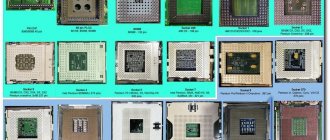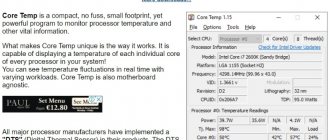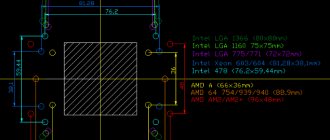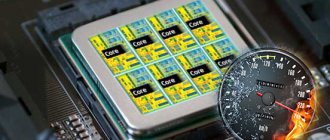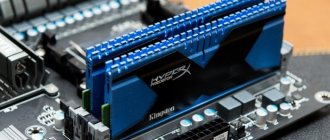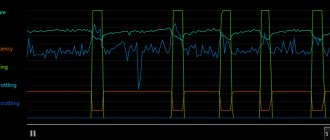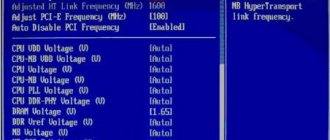A simple explanation of the question “what is a processor”
The microprocessor is one of the main devices in a computer. This dry official name is often shortened to simply “processor”). The processor is a microcircuit with an area comparable to a matchbox
. If you like, the processor is like the engine in a car. The most important part, but not the only one. The car also has wheels, a body, and a player with headlights. But it is the processor (like a car engine) that determines the power of the “machine”.
Many people call a processor a system unit - a “box” inside which all the PC components are located, but this is fundamentally wrong. The system unit is the computer case along with all its component parts - hard drive, RAM and many other parts.
CPU size compared to a coin. There are larger processors, and there are also much smaller ones.
Processor Function - Compute
. It doesn't matter which ones exactly. The fact is that all computer work is based solely on arithmetic calculations. Addition, multiplication, subtraction and other algebra - all this is done by a microcircuit called a “processor”. And the results of such calculations are displayed on the screen in the form of a game, a Word file, or just a desktop.
The main part of the computer that does the calculations is the processor.
.
up
What is a processor core and multi-core
From the beginning of processor centuries, these microcircuits were single-core. The core is, in fact, the processor itself. Its main and main part. Processors also have other parts - say, “legs”-contacts, microscopic “electrical wiring” - but it is the block that is responsible for calculations that is called the processor core
. When processors became very small, engineers decided to combine several cores inside one processor “case”.
If you imagine a processor as an apartment, then the core is a large room in such an apartment. A one-room apartment is one processor core (a large room-hall), a kitchen, a bathroom, a corridor... A two-room apartment is like two processor cores along with other rooms. There are three-, four-, and even 12-room apartments. The same is the case with processors: inside one “apartment” crystal there can be several “room” cores.
Multi-core
- This is the division of one processor into several identical functional blocks.
The number of blocks is the number of cores inside one processor. up
Types of multi-core processors
There is a misconception: “the more cores a processor has, the better.” This is exactly how marketers, who are paid to create this kind of misconception, try to present the matter. Their task is to sell cheap processors, moreover, at higher prices and in huge quantities. But in fact, the number of cores is far from the main characteristic of processors.
Let's return to the analogy of processors and apartments. A two-room apartment is more expensive, more comfortable and more prestigious than a one-room apartment. But only if these apartments are located in the same area, equipped in the same way, and their renovation is similar. There are weak quad-core (or even 6-core) processors that are significantly weaker than dual-core ones. But it’s hard to believe in this: of course, the magic of large numbers 4 or 6 against “some” two. However, this is exactly what happens very, very often. It seems like the same four-room apartment, but in a ruined state, without renovation, in a completely remote area - and even at the price of a luxurious two-room apartment in the very center.
up
Overclocking and unlocking
The frequency potential of new processors is always of some interest, especially when it comes to relatively inexpensive chips. There were no noticeable architectural or technological changes here, so the obtained values were generally predictable. After increasing the supply voltage to 1.475 V, the frequency of the test Athlon II X3 435 was increased to 3813 MHz (14.5 × 263 MHz). A very good result, on par with the successful Athlon II X2.
When testing the latest AMD processors, trying to unlock something useful in the new product has already become one of the mandatory steps. And this time we were in for a little surprise. After activating ACC technology in the BIOS, the CPU-Z utility identified the processor as Phenom II X4 B35, belonging to the Deneb family of chips. Moreover, in addition to the fourth core, a 6 MB third-level cache memory has also become available. Most likely, this is a temporary phenomenon and we will see the Athlon II X3 with the L3 cache hidden in the depths only in selected copies from the first batches of CPU data. Obviously, AMD resorted to such a step only to avoid a shortage by ensuring the required number of processors immediately after their announcement.
After unlocking the fourth core and cache memory, the overclocking potential decreased slightly. Stable operation of the processor was achieved at 3523 MHz (14.5×243 MHz), but in this case the unlocked core and capacious L3 more than compensate for the difference in frequency.
It should be recalled that only owners of boards equipped with SB710/SB750 southbridges with Advanced Clock Calibration technology can participate in the “lottery”. That is, we are talking about relatively new models. Perhaps in this way AMD is trying to push users to switch from aging platforms to more progressive ones. Although, I must admit, he does this very unobtrusively.
How many cores are there inside a processor?
For personal computers and laptops, single-core processors have not been produced properly for several years, and it is very rare to find them on sale. The number of cores starts from two. Four cores - as a rule, these are more expensive processors, but there is a return from them. There are also 6-core processors, which are incredibly expensive and much less useful in practical terms. Few tasks can achieve a performance boost on these monstrous crystals.
There was an experiment by AMD to create 3-core processors, but this is already in the past. It turned out quite well, but their time has passed.
By the way, AMD also produces multi-core processors, but, as a rule, they are significantly weaker than competitors from Intel. True, their price is much lower. You just need to know that 4 cores from AMD will almost always turn out to be noticeably weaker than the same 4 cores from Intel.
Now you know that processors come with 1, 2, 3, 4, 6 and 12 cores. Single-core and 12-core processors are very rare. Triple-core processors are a thing of the past. Six-core processors are either very expensive (Intel) or not so strong (AMD) that you pay more for the number. 2 and 4 cores are the most common and practical devices, from the weakest to the most powerful.
up
Number of Cores
The core is the most important element of the central processor. It is a part of the processor that can execute one thread of instructions. The cores differ in cache memory size, bus frequency, manufacturing technology, etc. Manufacturers assign new names to them with each subsequent technological process (for example, the AMD processor core is Zambezi, and Intel is Lynnfield). With the development of processor production technologies, it has become possible to place more than one core in one case, which significantly increases CPU performance and helps to perform several tasks simultaneously, as well as use several cores in programs. Multi-core processors will be able to cope faster with archiving, video decoding, running modern video games, etc. For example, Intel's Core 2 Duo and Core 2 Quad processor lines, which use dual-core and quad-core CPUs, respectively. Currently, processors with 2, 3, 4 and 6 cores are widely available. A larger number of them are used in server solutions and are not required by the average PC user.
Multi-core processor frequency
One of the characteristics of computer processors is their frequency. Those same megahertz (and more often gigahertz). Frequency is an important characteristic, but far from the only one
. Yes, perhaps not the most important one. For example, a 2-gigahertz dual-core processor is a more powerful offering than its 3-gigahertz single-core sibling.
It is completely wrong to assume that the frequency of a processor is equal to the frequency of its cores multiplied by the number of cores. To put it simply, a 2-core processor with a core frequency of 2 GHz has a total frequency in no case equal to 4 gigahertz! Even the concept of “common frequency” does not exist. In this case, the processor frequency
equal exactly 2 GHz. No multiplication, addition or other operations.
And again we will “turn” processors into apartments. If the height of the ceilings in each room is 3 meters, then the total height of the apartment will remain the same - the same three meters, and not a centimeter higher. No matter how many rooms there are in such an apartment, the height of these rooms does not change. The same goes for the clock speed of the processor cores.
.
It does not add up and does not multiply. up
Principle of operation
Most modern multi-core processors work according to the following scheme. If a running application supports multithreading, it can force the processor to perform multiple tasks at the same time. For example, if the computer uses a 4-core processor with a clock frequency of 1.8 GHz, the program can “load” all four cores with work at once, while the total processor frequency will be 7.2 GHz. If several programs are running at once, each of them can use part of the processor cores, which also leads to an increase in computer performance.
Many operating systems support multithreading, so using multi-core processors can speed up your computer even in applications that do not support multithreading. If we consider the operation of only one application, then the use of multi-core processors will be justified only if this application is optimized for multithreading. Otherwise, the speed of a multi-core processor will not be different from the speed of a regular processor, and sometimes it will even work slower.
Virtual multi-core, or Hyper-Threading
There are also virtual processor cores
.
Hyper-Threading technology in Intel processors makes the computer “think” that there are actually 4 cores inside a dual-core processor. It is very similar to how a single hard drive is divided into several logical ones
- local drives C, D, E, and so on.
Hyper- Threading is a very useful technology in a number of tasks.
. Sometimes it happens that the processor core is only half used, and the remaining transistors in its composition are idle. Engineers came up with a way to make these “idlers” work too, by dividing each physical processor core into two “virtual” parts. It’s as if a fairly large room was divided into two by a partition.
Does this trick with virtual cores
? Most often - yes, although it all depends on the specific tasks. It seems that there are more rooms (and most importantly, they are used more rationally), but the area of the room has not changed. In offices, such partitions are incredibly useful, and in some residential apartments too. In other cases, there is no point at all in partitioning the room (dividing the processor core into two virtual ones).
Note that the most expensive and
Core processors are necessarily equipped with Hyper- Threading
.
They have 4 physical cores and 8 virtual ones. It turns out that 8 computational threads work simultaneously on one processor. Less expensive, but also powerful Intel Core i5
have four cores, but Hyper Threading does not work there. It turns out that Core i5 work with 4 threads of calculations.
Core
i3
processors are typical “mid-range”, both in price and performance.
They have two cores and no hint of Hyper-Threading. In total, it turns out that the Core i3
only two computational threads.
The same applies to frankly budget Pentium and Celeron
.
Two cores, no hyper-threading = two threads. up
What is core and thread
A core , simply put, is a physical unit of a processor capable of executing one sequence of commands at a specific point in time. If there is one core, but there are many commands, the core switches between them, performing tasks one by one depending on priority.
A thread is also sometimes called a virtual core - the result of modern technologies (in processors manufactured by Intel - this technology is called Hyper Threading, and in AMD - SMT technology), when the core, with the help of special technologies, is able to share its performance. The expression one core and two threads means that physically there is one core, but this core is virtually divided into two and allows you to parallelize tasks and solve them simultaneously. That is, given two relatively “simple tasks,” the processor will be able to complete them twice as fast as a conventional single-core processor. An example of such tasks could be downloading files in the background or running an antivirus. The technology for creating threads allows you to create several parallel computing channels, which allows you to use the capabilities of computers more efficiently, since if one of the virtual cores has finished its work, it can join the work of another core. Performance will increase, but the increase will be limited, since the resources are used (clock frequency is measured in MHz, that is, computing power) of the physical core, which we have only one. Only by using special programs that work with hyperthreading and with proper optimization can you experience an increase in performance.
We can conclude that when working with “simple” tasks, a single-core processor with two threads is comparable in performance to “real” dual-core processors, but if the tasks are “complex”, such as archiving, video rendering, then to increase performance you should think about purchasing a processor with a large number of cores. Since multi-core processors are more preferable for serious tasks than multi-threaded ones.
Does a computer need many cores? How many cores does a processor need?
All modern processors are powerful enough for common tasks
. Browsing the Internet, correspondence on social networks and by e-mail, office tasks Word-PowerPoint-Excel: weak Atom, budget Celeron and Pentium are suitable for this work, not to mention the more powerful Core i3. Two cores are more than enough for normal work. A processor with a large number of cores will not bring a significant increase in speed.
Core i3 or i5
processors . Rather, gaming performance will depend not on the processor, but on the video card. Rarely will a game require the full power of a Core i7. Therefore, it is believed that games require no more than four processor cores, and more often two cores are suitable.
For serious work like special engineering programs, video encoding and other resource-intensive tasks, truly productive equipment is required
.
Often, not only physical, but also virtual processor cores are used here. The more computing threads, the better. And it doesn’t matter how much such a processor costs: for professionals, the price is not so important. up
Test results
In a situation where there are virtually no architectural changes in new processors, interest turns to the practical plane. There is a desire to find out what the new models can offer in terms of performance and how good they are in terms of price/performance ratio. When your eyes run wide from the variety of assortments, choosing the most suitable option is not so easy. To compare the capabilities of new products and predecessors, we selected several models already on the market from various lines in the price range of $80–120.
When working with media content, the Athlon II X3 copes no worse than the more expensive Phenom II X3. When encoding video, the increased CPU frequency compensates for the lack of a large cache. The Athlon II X3 435 is almost 30% ahead of the equal-frequency Athlon II X2. The situation is similar with archiving in 7-Zip. However, the impact of the amount of cache memory required to store the dictionary is slightly higher here. This is clearly seen in the results of the Phenom II X3 720, which, although it could not catch up with the quad-core CPU, was 7–10% ahead of the Athlon II X3 processors lacking L3. When rendering a scene in the Cinebench R10 test, Rana chips look quite convincing - the Athlon II X3 435 competes on an equal footing with the Phenom II X3 720, having a serious advantage over dual-core CPUs.
As expected, processors with a larger number of processing cores are more productive in multi-threaded tasks. If you often use such applications in your work, purchasing an Athlon II X4 will be preferable, even despite the higher cost than triple-core models. However, when it comes to games, the situation here is no longer so clear. In Far Cry 2, the Phenom II X2 550 came close to the Athlon II X3 group, while dual-core chips without L3 lagged noticeably behind. The Athlon II X4 barely caught up with the tri-core models, but the Phenom II X3 720 was out of competition here.
Crysis was one of the first games to take advantage of multi-core processors, but only actively utilizes two threads. This situation worked to the advantage of the Phenom II X2 550. Thanks to 6 MB of shared L3 cache, it managed to outperform the new tri-core processors. Still, for toys, a capacious cache is a very useful thing. The Athlon II X4 620 with a relatively low nominal frequency of 2.6 GHz seriously lost its ground, demonstrating results at the level of chips from the Athlon II X2 family. Well, the Phenom II X3 720 became the sole leader. Whether the resulting performance gain is worth the price difference is up to you to decide.
As measurements have shown, the power consumption of the new processors is approximately the same as that of the triple-core Phenom II X3, but less than that of the Athlon II X4. However, one should take into account the fact that the tested CPU instance is “blue-blooded” - it is still based on a quad-core Deneb, while most Athlon II X3 will lack L3 cache at the physical level, which will also affect power consumption.
Are there any benefits to multi-core processors?
Absolutely yes. At the same time, the computer is engaged in several tasks - at least running Windows (by the way, these are hundreds of different tasks) and, at the same moment, playing a movie. Playing music and browsing the Internet. The work of a text editor and the included music. Two processor cores - and this is, in fact, two processors - will cope with different tasks faster than one. Two cores will make this a little faster. Four is even faster than two.
In the first years of the existence of multi-core technology, not all programs were able to work even with two processor cores. By 2014, the vast majority of applications understand and can take advantage of multiple cores. The speed of processing tasks on a dual-core processor rarely doubles, but there is almost always a performance increase.
Therefore, the deep-rooted myth that programs cannot use multiple cores is outdated information. Once upon a time this was indeed the case, today the situation has improved dramatically. The benefits of multiple cores are undeniable, that's a fact.
up
About the number of cores and processor frequency
It is impossible to say unequivocally what is more important, the frequency or the number of cores. These things are too different. The fact is that the processor frequency is the number of operations per second. The higher the frequency, the more actions the processor performs in one pass. It's like transporting cargo: the faster you drive, the sooner you will deliver the goods to your destination. There are no other options. If you take two identical processors, but with different frequencies, you can guarantee that the one with the higher operating frequency will be faster.
It's more difficult with multi-cores. Two cores can process several tasks simultaneously. And ideally, they will work much faster than a single-core solution. But here it all depends on the program or game itself: can it divide the task at hand into several simple actions and load both cores with them? For ease of understanding, let’s return to the example of transporting goods. If you have two trucks, they can carry twice as much cargo. But this is only provided that the cargo can be divided into parts. But what if this is, say, an already assembled car that cannot be disassembled and cannot be cut in half? Then only one truck will go with the cargo, and the second will stand idle and do nothing useful. Same with processors. If the program cannot break the task into parts, then only one core will work and the speed will depend only on its frequency.
In addition to the frequencies and number of cores, there is another important factor - the processor architecture. Actually, this is how the processor operates on the received data. Let's take, again, our cargo. For example, one driver knows the road better than another and knows where to take a shortcut, and therefore gets to the place faster than his companion. It's the same with processors. The more rationally its resources are used, the faster it will work. This is why, for example, Intel processors under the same conditions are often faster than AMD solutions.
Now, understanding what the main characteristics of the processor influence, we can talk about which of them is more important for you. Multi-core helps with video conversion, working with audio, rendering pictures in 3DS Max, etc. These are simple processes that can always be divided into components and put together after calculation. With games everything is much more complicated, it depends on how you get there. Some developers are involved in parallelizing tasks in game code, while others are not. But the trend “more cores - faster game” is still visible. This is clearly visible when comparing old games with new ones. For example, Crysis, a game from three years ago, runs significantly faster on a dual-core processor with a frequency of 4.5 GHz than on a quad-core processor with 2.6 GHz. However, you shouldn't rush out and run for a quad-core processor. There are many other factors to consider before purchasing, the main one being the video card. In games, processors are revealed only when graphics are processed by a powerful board, for example, GTX 480 or Radeon HD5870. If something budget is responsible for the graphics, then you simply won’t feel the difference between the same Core i3 and Core i7, because the performance in this case will be limited by the video card.
When the processor has fewer cores, it’s better
You should not buy a processor using the incorrect formula “the more cores, the better.” This is wrong. Firstly, 4, 6 and 8-core processors are significantly more expensive than their dual-core counterparts. A significant increase in price is not always justified from a performance point of view. For example, if an 8-core processor turns out to be only 10% faster than a CPU with fewer cores, but is 2 times more expensive, then it will be difficult to justify such a purchase.
Secondly, the more cores a processor has, the more voracious it is in terms of energy consumption. There is no point in buying a much more expensive laptop with a 4-core (8-thread) Core i7 if this laptop will only process text files, browse the Internet, and so on. There will be no difference with the dual-core (4 threads) Core i5, and the classic Core i3 with only two computing threads will not be inferior to its more eminent “colleague”. And such a powerful laptop will last much less on battery power than the economical and undemanding Core i3.
up
How many cores do you need for gaming?
Reward accrued
This material was written by a site visitor and was compensated for.
The problem of the 21st century is choosing the number of cores in a processor. The performance of models from Intel and AMD differs in many ways and in different tasks. Somewhere the priority is a larger number of cores, somewhere performance per core and high frequency. We are simple people - we play games. How many cores should we choose?
About kernels.
announcements and advertising
2080 Super Gigabyte Gaming OC for 60 rubles.
Compeo.ru - the right comp store without any tricks
RTX 2060 becomes cheaper before the arrival of 3xxx
Ryzen 4000
series included in computers already in Citylink
The price of MSI RTX 2070 has collapsed after the announcement of RTX 3xxx
Core i9 10 series is half the price of the same 9 series
The price of memory has been halved in Regard - it’s more expensive everywhere
In simple terms, the number of cores determines how many tasks the processor can handle simultaneously. Once upon a time, all processors were single-core and did not support multitasking. They only knew how to quickly switch between priority tasks. With the release of Athlon and Pentium processors, the first multi-core “stones” entered the consumer market. The so-called “nuclear revolution” took place, their number grew by leaps and bounds. Currently, among the user segment there are 4, 8, 16 and even 32-core models. The AMD Ryzen series “ate the dog” in terms of the number of cores.
More recently, all computer games could use only one physical core; installing a dual-core processor did not give much of anything. Over time, game manufacturers have learned to use a large number of cores, which has a positive effect on gaming performance.
Soon after the release of multi-core processors, multi-threading technology appeared - Hyper-threading from Intel and SMT from AMD. The technology allows you to divide the physical core into two logical threads. Processing occurs in sequence mode and is much faster than a regular kernel. Do logical cores replace full-fledged physical ones - yes! Take a look at the statistical benchmark.
It follows from the table that the performance of a multi-threaded dual-core processor is almost comparable to a full-fledged quad-core one. So the seventh generation i3 processor with 4 logical threads in games turned out to be faster than the sixth generation i5 with full 4 cores. Further increase in the number of cores and threads does not bring any significant results.
In games, it is not the number of cores that matters, but their efficiency. A striking example of this is the AMD FX series processors. They were released in 2011 and 2012, relying solely on the maximum number of cores. At one time, they made a breakthrough in multi-core technology, which served as a good impetus for the company. As the years passed, the FX series stagnated while Intel continued to develop its cores. Ultimately, the dual-core, multi-threaded Intel Pentium 4560 turned out to be faster in gaming projects than the 8-core “stone” from AMD.
Another example of “bad” cores is the old Xeon series server processors. Recently, demand for them has increased due to the fashion for the number of threads, as well as a decrease in the cost of used ones. market. For the price of a “hyper stump” you can buy a twenty-thread processor with good performance. There's just one catch. This processor, while excellent at performing tasks in technical areas, is completely unsuited for gaming. If you are on the verge of buying a Xeon, then the best choice will be a processor with the maximum number of cores and the highest possible frequency. Their per-core performance is far from modern and resembles the FX series. But unlike the latter, Xeon has many more cores, which compensates for their low performance. In the end, it turns out that the old 20-thread server processors only match the gaming performance of the latest generation Intel i5 series.
About performance.
In order to test gaming performance in various variations of cores and threads, let's take the ten-core, twenty-thread Intel Core i9 7900X. We will make different combinations of it and look at the difference in gaming performance. The AMD Ryzen 7 2700X will also be added to the test at base frequencies and using all cores.
Test stand:
- Processor – Intel Core i9 7900X Skylake-X 10-core CPU @ 4.5 GHz.
- Motherboard - ASUS Strix X299-XE Gaming.
- Memory – G.Skill Trident Z 32 GB DDR4-3200 CL14.
- Video card - NVidia GeForce GTX 1080 Ti.
- Storage – 2x SSD Samsung 840 Evo 1TB.
- OS - Windows 10 64-bit.
The dual-core processor, although it produces playable FPS, slows down the card a lot. The right choice would be a 4-6 core processor with or without Hyper-threading support. As resolution increases, performance is limited by the video card; here, a dual-core processor produces comparable results.
This game apparently doesn't know what threads and cores are. The result is the same within the error.
Here we also made sure that 4 cores are enough to “open up” the video card.
Just like Call of Duty, this project either cannot use more than 4 threads, or is so well optimized that a dual-core processor is enough for maximum performance.
It is better not to approach this game with 4-thread Pentium and i3. Starting with four cores, there is practically no increase in performance.
About choice.
You have all heard your friends say that after purchasing a new video card, their processor stopped “revealing” it. So how many cores do you need to “open”? Modern cores, starting with the 6th generation of Intel and the Ryzen line from AMD, have excellent performance per core. According to the table above, today there is no need to use a modern processor with more than four cores for games. It can be either multi-threaded or with physical cores. Based on the results of gaming testing, it is clear that in some projects there is a slight gap between an eight-thread processor and a quad-core processor without Hyper-threading. The latest generation six-core Coffee Lake processors will perfectly cover this small shortcoming. It turns out that the best choice at the moment is the i5 and Ryzen 5 series processors. Their performance will be enough to “unleash” a high-end video card in FullHD. Anything with more cores and threads is a waste of money. The only justified purchase of such processors lies in the use of two or more video cards for games in 4-8k resolutions.
Multi-core processors in mobile phones and tablets
The fashion for multiple computing cores inside one processor also applies to mobile devices. Smartphones and tablets with a large number of cores almost never use the full capabilities of their microprocessors. Dual-core mobile computers sometimes actually work a little faster, but 4, and even more so 8 cores are frankly overkill. The battery is consumed absolutely ungodly, and powerful computing devices simply sit idle. Conclusion - multi-core processors in phones, smartphones and tablets are just a tribute to marketing, and not an urgent need. Computers are more demanding devices than phones. They really need two processor cores. Four won't hurt. 6 and 8 are overkill for normal tasks and even games.
up
How to choose a multi-core processor and not make a mistake?
The practical part of today's article is relevant for 2014. It is unlikely that anything will change significantly in the coming years. We will only talk about processors manufactured by Intel. Yes, AMD offers good solutions, but they are less popular and more difficult to understand.
Note that the table is based on processors from 2012-2014. Older samples have different characteristics. We also did not mention rare CPU options, for example, the single-core Celeron (there are such even today, but this is an atypical option that is almost not represented on the market). You should not choose processors solely by the number of cores inside them - there are other, more important characteristics. The table will only make it easier to choose a multi-core processor, but a specific model (and there are dozens of them in each class) should be purchased only after carefully familiarizing yourself with their parameters: frequency, heat dissipation, generation, cache size and other characteristics.
| CPU | Number of Cores | Computational threads | Typical Applications |
| Atom | 1-2 | 1-4 | Low-power computers and netbooks. The goal of Atom processors is to minimize power consumption. Their productivity is minimal. |
| Celeron | 2 | 2 | The cheapest processors for desktops and laptops. The performance is sufficient for office tasks, but these are not gaming CPUs at all. |
| Pentium | 2 | 2 | Intel processors are just as inexpensive and low-performance as Celeron. An excellent choice for office computers. Pentiums are equipped with a slightly larger cache, and, sometimes, slightly increased performance compared to Celeron |
| Core i3 | 2 | 4 | Two fairly powerful cores, each of which is divided into two virtual “processors” (Hyper-Threading). These are already quite powerful CPUs at not too high prices. A good choice for a home or powerful office computer without much performance requirements. |
| Core i5 | 4 | 4 | Full-fledged 4-core Core i5 processors are quite expensive. Their performance is lacking only in the most demanding tasks. |
| Core i7 | 4-6 | 8-12 | The most powerful, but especially expensive Intel processors. As a rule, they are rarely faster than Core i5, and only in some programs. There are simply no alternatives to them. |
up
Summary testing: dual- and triple-core AMD and Intel processors (Part 1)
- Introduction
- Test participants and their overclocking
- Software used and testing methodology
- Open testbed configuration
- Results. CPU tests
- Complex tests
- Synthetics
- Scientific applications and programming
- Working with 2D graphics
- Working with 3D graphics
- Audio and video encoding
- Raster image processing
A few months ago, an article was published on our website in which we compared the performance of dual-core Intel processors based on the Core architecture.
As was rightly noted by the readers of our forum, there were several shortcomings in this article, the most important of which was the lack of AMD processors, as well as quad-core CPUs from Intel. In today's article we present you with testing of dual- and triple-core AMD processors, and also compare them with competitors. Within the framework of a slightly modified, but still the same socket (AM2 for AMD and LGA775 for Intel), the two largest processor manufacturers produced CPUs of different architectures. In today's testing, unlike in the past, we decided to test not only modern products, but also one previously popular and widespread processor, such as the AMD Athlon X2 6000+.
So, review participants:
- AMD Athlon X2 6000+ (3000 MHz);
- AMD Athlon X2 7550 (2500 MHz);
- AMD Athlon II X2 250 (3000 MHz);
- AMD Phenom II X2 550 Black Edition (3100 MHz);
- AMD Phenom X3 8750 (2400 MHz);
- AMD Phenom II X3 720 Black Edition (2800 MHz).
When choosing a CPU, we deliberately refused to test so-called energy-efficient processors with the letter e
in the name, since their level of performance is comparable to ordinary ones. Phenom generation processors were selected in such a way that they did not contain the TLB error. The only participant from the K8 architecture, the Athlon X2 6000+, is presented in its “large” 90 nm version, since, to our deepest regret, a 65 nm copy could not be found. The main characteristics of the tested processors are summarized in the table.
| CPU | AMD Athlon X2 6000+ | AMD Athlon X2 7550 | AMD Athlon II X2 250 | AMD Phenom II X2 550 BE | AMD Phenom X3 8750 | AMD Phenom II X3 720 BE |
| Technical process | 90 nm | 65 nm | 45 nm | 45 nm | 65 nm | 45 nm |
| Rated frequency | 3000 MHz | 2500 MHz | 3000 MHz | 3100 MHz | 2400 MHz | 2800 MHz |
| Core | Windsor | Kuma | Regor | Callisto | Toliman | Heka |
| Number of Cores | 2 | 2 | 2 | 2 | 3 | 3 |
| HyperTransport bus frequency | 1000 MHz | 1800 MHz | 2000 MHz | 2000 MHz | 1800 MHz | 2000 MHz |
| Factor | 15,0 | 12,5 | 15,0 | 15,5* | 12,0 | 14* |
| Cache memory | 2*1 MB L2 | 2*512 KB L2 + 2 MB L3 | 2*1 MB L2 | 2*512 KB L2 + 6 MB L3 | 3*512 KB L2 + 2 MB L3 | 3*512 KB L2 + 6 MB L3 |
| TDP | 125 W | 95 W | 65 W | 80 W | 95 W | 95 W |
| Kernel revision | F3 | B3 | C2 | C2 | B3 | C2 |
| x86-64 | + | + | + | + | + | + |
| Virtualization Technology | + | — | + | + | — | + |
| Announcement date | February 20, 2007 | December 15, 2008 | July 02, 2009 | July 02, 2009 | April 23, 2008 | February 09, 2009 |
| Date of discontinuation | April 28, 2009 | First quarter of 2009 | At the time of writing, no date has been set. | At the time of writing, no date has been set. | At the time of writing, no date has been set. | At the time of writing, no date has been set. |
| Screenshot of CPU-Z** |
* - these processors have an unlocked multiplier. ** - screenshots of CPU-Z used in testing processors.
The processors operated in three operating modes:
- nominal mode;
- mode with the same frequency of 3096 MHz with a x12 multiplier and a clock generator frequency of 258 MHz. The frequencies of the HyperTransport bus and the northbridge built into the core were chosen to be the same for all processors;
- maximum overclocking mode with a nominal multiplier (for processors with an unlocked multiplier, the most optimal multiplier/clock generator frequency ratio was selected).
announcements and advertising
2080 Super Gigabyte Gaming OC for 60 rubles.
Compeo.ru - the right comp store without any tricks
RTX 2060 becomes cheaper before the arrival of 3xxx
Ryzen 4000
series included in computers already in Citylink
The price of MSI RTX 2070 has collapsed after the announcement of RTX 3xxx
Core i9 10 series is half the price of the same 9 series
The price of memory has been halved in Regard - it’s more expensive everywhere
All processors were suitable for identical operation except the AMD Athlon X2 6000+, which is not capable of operating under the specified conditions. It showed such a modest overclocking potential (the maximum stable frequency did not exceed 3200 MHz) that it was also decided to abandon its use in the third mode. For the same reason, the AMD Phenom X3 8750 is not available in the latter mode. When searching for the maximum stable processor frequency, the HyperTransport values, as well as the northbridge built into the core, were chosen as close as possible to the nominal ones.
Modern CPUs from AMD have the theoretical ability to unlock one or more cores, as well as the cache. Of the available processors, only the AMD Phenom II X3 720 BE succeeded, which “turned” into the older AMD Phenom II X4. For the convenience of the author and readers, this processor will henceforth be called the Phenom II X4 720 BE.
The overclocking potential of the three- and four-core processor has not changed. Attempts to unlock the AMD Phenom II X2 550 BE were unsuccessful, however, its performance if successful would be comparable to the X4 720 BE.
The table with processor operating modes is given below.
| CPU | Nominal operating mode | Same frequency mode | Maximum overclocking mode | |||||||||
| Processor frequency and operating mode | RAM frequency | RAM timings (CL-tRCD-tRP-tRAS-tRC-CR) | Frequency HT/(NB) | Processor frequency and operating mode | RAM frequency | RAM timings (CL-tRCD-tRP-tRAS-tRC-CR) | Frequency HT/(NB) | Processor frequency and operating mode | RAM frequency | RAM timings | Frequency HT/(NB) | |
| Athlon X2 6000+ | 3000 MHz (200x15) | 800 MHz | 5-5-5-15-23-2T | 1000 MHz | The processor has not been tested in this mode | The processor has not been tested in this mode | ||||||
| Athlon X2 7550 | 2500 MHz (200x12.5) | 1800 MHz | 3096 MHz (258×12) | 860 MHz | 5-5-5-15-23-2T | 2064/2064 MHz | 3400 MHz (270x12.5) | 906 MHz | 5-5-5-15-23-2T | 1904 MHz | ||
| Athlon II X2 250 | 3000 MHz (200x15) | 2000/2000 MHz | 3810 MHz (254x15) | 847 MHz | 2032/2034 MHz | |||||||
| Phenom II X2 550 BE | 3100 MHz (200x15.5) | 3798 MHz (2245x15.5) | 980 MHz | 1960/1960 MHz | ||||||||
| Phenom X3 8750 | 2400 MHz (200x12) | 1800 MHz | The processor has not been tested in this mode | |||||||||
| Phenom II X3 720 BE | 2800 MHz (200x14) | 2000/2000 MHz | 3690 MHz (246x15) | 984 MHz | 2214/2214 MHz | |||||||
| Phenom II X4 720 BE | ||||||||||||
The stability of the overclocked system was checked by a half-hour test of Prime95 x64 version 25.9 in Blend and Small FFTs mode, as well as twenty runs of the LinX utility in x64 mode. When overclocking processors, the voltage supplied to them averaged 1.45 - 1.5 V. To prevent possible distortion of the results, secondary RAM timings were set through the MemSet 4.0 utility.
For correct comparison with the results of Intel processors shown in the previous article, the testing tools and methodology were not changed.
All tests were carried out under the Windows Vista Ultimate x64 SP1 operating system with the following drivers and libraries installed:
- DirectX libraries - March 2009;
- ATI video card drivers – Catalyst 9.2;
- PhysX software - 9.09.0203.
The operating system and driver settings did not undergo any changes and operated at default values. During testing, the swap file was set to zero, except for the game Warhammer 40K Dawn of War 2, which requires at least 1.5 GB to run.
The following software was used during testing:
- PCMark05 v. 1.2.0 - default settings;
- PCMark Vantage v. 1.0.0 x64 - default settings;
- PassMark PerformanceTest 7.0 x64 is a comprehensive computer performance test. Tests were carried out without a connected DVD drive. The overall results of the test (Overall), as well as the separate number of points scored by the processor (CPU), are given. The bigger the result, the better;
- Hexus PiFast v. 4.1 - test result - execution time in seconds. The smaller the result, the better;
- SuperPI 1.5 modXS – calculation of pi with an accuracy of 1M and 8M. The test result is the execution time in seconds. The smaller the result, the better;
- wPrime v. 1.55 – 32M test with the maximum possible number of cores. The test result is the execution time in seconds. The smaller the result, the better;
- NuclearMC v. 2.0.0 RC1 - the Total Score value is given;
- Titan Benchmark v. 1.1 beta - the overall test results (Overall) are shown, as well as the number of points scored by the processor (CPU). The bigger the result, the better;
- Universal CPU Benchmark v. 1.02 - testing was carried out in two modes with one or the maximum number of cores involved. The bigger the result, the better;
- Lavalys Everest v. 5.0.1650 - four RAM tests are given. In the Latency test, the lower the result, the better, in the other three it’s the opposite;
- Fritz Chess Benchmark v. 4.2 - testing was carried out in two modes with one or the maximum number of cores involved. The bigger the result, the better;
- 7-zip 4.64 x64 - results of the built-in benchmark are shown;
- Microsoft Visual Studio 9 - project compilation time. The smaller the result, the better;
- ScienceMark 2 - the Overall Score value of the built-in benchmark is given. The bigger the result, the better;
- TOC [email protected] bench v. 0.4.7.0 — the PPD value of one thread of the DGRomacs1
. The bigger the result, the better; - Wolfram Mathematica 7.0 x64 - testing in a well-known mathematical package. The result is taken as the value of the processor performance rating as assessed by the built-in benchmark. The bigger the result, the better;
- Waterloo Maple 12 - testing in a well-known mathematical package. The calculation time of the test task is taken as the result. The smaller the result, the better;
- Autodesk Autocad 2009 x64 - testing using the Cadalyst Autocad c2008v5.1
. The result is taken as the value of the processor performance rating. The bigger the result, the better; - Maxon Cinebench R10 x64 – testing was carried out in two modes with one or the maximum number of cores involved. The bigger the result, the better;
- LightWork Renderbench – rendering a scene with a resolution of 800×600. The test result is the rendering time of the test image in seconds. The smaller the result, the better;
- PovRay v. 3.7 beta 31 - testing was carried out by the built-in benchmark in two modes with one or the maximum number of cores involved. Since at the time testing began, a version for 64-bit OS was not available for download, the 32-bit version of the program was used. The bigger the result, the better;
- Blender v. 2.48a x64 is a cross-platform package for working with computer graphics. Testing was carried out in two modes with one or the maximum number of cores involved. The test result is the rendering time of the test image in seconds. The smaller the result, the better;
- Autodesk Maya 2009 - testing using the SpecAPC v.6.5
. The result is taken as the value of the processor performance rating during rendering. The bigger the result, the better; - Autodesk 3ds Max 2009 x64 - testing using the SpecAPC
for 3ds Max 9. The result is the processor performance rating for rendering. The bigger the result, the better; - KribiBench v. 1.1 — construction of a three-dimensional city
using processor resources. The result is the FPS value. The bigger the result, the better; - SwiftShader v. 2.01 - software 3D rendering from TransGaming Technologies (known for their product for Unix systems called Cedega), working on the principle of replacing DirectX libraries. Testing is performed at a resolution of 1024x768 CubeMap
. The result is the FPS value. The bigger the result, the better; - RealStorm Bench 2006 - creating images using ray tracing. The result is the number of Raymarks obtained with the default settings. The bigger the result, the better;
- iTunes v. 8.0.2.2 x64 - the size of the test audio file in WAV format is 500 MB. The test result is the encoding time of the test audio file from WAV format to ACC. The smaller the result, the better;
- Flac v. 1.2.1b - the size of the test audio file in WAV format is 500 MB. Encoding options: --best -f
. The test result is the encoding time of the test audio file from WAV to FLAC format. The smaller the result, the better; - Lame v. 3.98.2 — the size of the test audio file in WAV format is 500 MB. Encoding options: -b 320 -ms -h
. The test result is the encoding time of the test audio file from WAV to MP3 format. The smaller the result, the better; - x264 HD Benchmark v. 0.59.819 – encoding of the test video supplied with the benchmark using the x264 codec. The test result is the FPS value of the first and second passes. The bigger the result, the better;
- DivX 6.8.5 - the duration of the test video file in MPEG-2 format is 5 minutes 44 seconds. Coding was carried out by the VirtualDubMod
v.1.5.10.2 program.
Codec settings: Certification Profile - Home Theater profile, Rate Control Mode - 1-pass quality-based, Enhanced multithreading - enabled
. The test result is FPS when encoding the test video file into AVI. The bigger the result, the better; - Xvid v. 1.2.1 - the duration of the test video file in MPEG-2 format is 5 minutes 44 seconds. Coding was carried out by the program VirtualDubMod v. 1.5.10.2. Codec settings: Encoding type - Single
. The test result is FPS when encoding the test video file into AVI. The bigger the result, the better; - Photoline v. 15.01 x64 - image processing program. The test result is the total execution time of all tests of the built-in benchmark on a test image of size 4129x2742. The smaller the result, the better;
- Photoshop CS3 is an image processing program. The result of the test is the execution time of the Retouch Artists Speed Test
on a test image of size 4129x2742 (the image supplied with the test was not used due to its small size). The smaller the result, the better.
Testing in gaming applications was carried out in three modes.
- Resolution 1280×1024, all settings to minimum (hereinafter on the graphs low, in the text “light mode”).
- Resolution 1680×1050, all settings to maximum NoAF, NoAA (hereinafter on the graphs high, in the text “medium mode”).
- Resolution 1920×1200, all settings to maximum AF16x, AA4x (hereinafter on the graphs very high, in the text “heavy mode”).
Participating in testing:
- 3DMark06 v. 1.1.0 – default settings, shows the overall test results (Overall), as well as separately the number of points scored by the processor (CPU);
- 3DMark Vantage v. 1.0.1 – Performance profile, shows the overall test results (Overall), as well as separately the number of points scored by the processor (CPU);
- Call of Duty 5: World at War v. 1.3 - performance testing in a test scene using the built-in benchmark;
- Enemy Territory: QUAKE Wars v. 1.5 - testing using the HardwareOC ETQW Bench v1.1.1.0 utility on the HOC Salvage card;
- FEAR: Perseus Mandate v. 1.0 — testing with built-in benchmark;
- Race Driver: Grid v. 1.2 — testing in the game using the FRAPS utility;
- GTA 4 v. 1.0.2.0 - testing with built-in benchmark;
- Left 4 Dead - testing performance in a test scene using the built-in benchmark;
- Prey v. 1.4 - testing using the HardwareOC Prey Benchmark v. utility. 1.3.0.0 (Boost graphics=enable);
- The Last Remnant - testing in the official benchmark;
- Unreal Tournament 3 v. 1.3 – testing using the HardwareOC UT3 Bench v1.3.0.0 utility on the Containment card;
- Empire: Total War v. 1.0 - testing in the game using the FRAPS utility;
- X3 Terran Conflict - testing in the official benchmark;
- STAKER Clear Sky - testing in the official benchmark in the first scene;
- Call of Juarez - testing in the official benchmark;
- Crysis Warhead v. 1.1 — testing in Framebuffer Crysis Warhead Benchmark Tool beta 32 in x64 mode;
- Devil May Cry 4 - testing in the official benchmark in the second scene;
- Far Cry 2 v. 1.2 — testing with built-in benchmark;
- Lost Planet: Extreme Conditions v. 1.0.0.4 – results of the built-in benchmark at the Cave and Snow levels are shown;
- Unigine Tropics Demo v. 1.1 – testing with built-in benchmark;
- World in Conflict v. 1.0.0.9 – testing with built-in benchmark;
- Warhammer 40K Dawn of War 2 - in-game testing using the FRAPS utility;
- Motherboard:
- Gigabyte GA-MA790GP-DS4H, AMD 790GX + SB750, BIOS F5* ;
- Asus P5K Premium, Intel P35, BIOS 0802** ;
- CPU:
- AMD Athlon X2 6000+ (3000 MHz)*;
- AMD Athlon X2 7550 (2500 MHz)*;
- AMD Athlon II X2 250 (3000 MHz)*;
- AMD Phenom II X2 550 Black Edition (3100 MHz)*;
- AMD Phenom X3 8750 (2400 MHz)*;
- AMD Phenom II X3 720 Black Edition (2800 MHz)*;
- Intel Celeron E1400 (2000 MHz)**;
- Intel Pentium Dual-Core E2200 (2200 MHz)**;
- Intel Core 2 Duo E4400 (2000 MHz)**;
- Intel Pentium Dual-Core E5200 (2500 MHz)**;
- Intel Core 2 Duo E6850 (3000 MHz)**;
- Intel Core 2 Duo E7400 (2800 MHz)**;
- Intel Core 2 Duo E8500 (3160 MHz)**;
- Palit Radeon HD 4870 Sonic Dual Edition 512 MB (GPU 750 MHz, MEM 950 MHz, during testing worked with GPU frequencies 825 MHz, MEM 1000 MHz) with a homemade water cooling system;
- Homemade water cooling system.
- Arctic Cooling MX2*;
- Tuniq TX-2**;
- 2x1024 MB DDR2 OCZ SLI Ready EPP OCZ2N900SR1G (PC7200, 900 MHz, 4-4-3-15, 2.1 V);
- 2 x 1024 MB DDR2 OCZ Reaper HPC OCZ2RPR10662GK (PC8500, 1066 MHz, 5-5-5-15, 2.1 V)*;
- 2 x 1024 MB DDR2 Patriot PSD21G8002 (PC6400, 800 MHz, 5-5-5-15, 1.8 V)**;
- Raid0 of 2xWestern Digital Raptor WD740ADFD, 10000 rpm, 16 MB, SATA, 74 GB;
- Thermaltake ToughPower 750W (W0116);
- 26″ View Sonic VP2650wb (Wide LCD, 1920 x 1200 / 60 Hz);
- Thermaltake A2309 iCage hard drive cage;
- Turbine for cooling the radiator above the mosfets, included with the Asus P5K Premium motherboard**;
- Low-speed fan 120 mm Cooler Master A12025-12CB-3BN-F1 for cooling elements of the board's power subsystem*;
- Low-speed fan 120 mm Cooler Master A12025-12CB-3BN-F1 for cooling elements of the video card power subsystem.
* - this equipment was used only as part of a bench for testing AMD processors. ** - this equipment was used only as part of a bench for testing Intel processors.
Since the last testing, the water cooling system has changed, in which the old processor water block was replaced with a more efficient Promodz CPU V3.
When constructing graphs, we used the same principle as in the previous article. In the nominal mode, as well as the mode with the maximum frequency, not only the results of AMD processors, but also Intel are shown. The parameters of CPUs from different companies in the same operating mode are not identical, and it is incorrect to compare them. In most cases, we will talk about older models, namely AMD Athlon II X2 250, Phenom X3 8750, Phenom II X2 550 BE, X3 720 BE, X4 720 BE, as well as Intel Pentium Dual-Core E5200, Core 2 Duo E6850, E7400, E8500.
Today's testing opens with complex tests, which include three applications. Let's start with the oldest of them, PCMark 05.
In the very first test, products from Intel, especially those produced using the 45-nm process technology, take the lead and show excellent results, both in nominal mode and with maximum overclocking. Unlocking the fourth core on the Phenom II X3 720 BE gives some performance boost, but this is not enough to compete on equal terms with the “blues”. In PCMark Vantage
the situation is changing radically.
Although dual-core processors from AMD are inferior to their rivals when overclocked, three- and quad-core CPUs show excellent results. In nominal mode, you can see fairly close indicators.
The next comprehensive benchmark called PerformanceTest
little known.
The results shown here are close to those in PCMark 05
.
In terms of overall performance, Intel processors have the upper hand, but the presence of more than two cores in a system unit certainly has a positive effect on its value. In the second part of the test, the advantage of the X3 and X4 looks convincing, especially with maximum overclocking, where the frequency of the 720 is almost 700 MHz lower than that of the E8500.
Let's continue testing in synthetic applications, where the difference in performance should be the greatest.
Let's start with programs that calculate pi. In such tests, the most important parameter is the processor frequency, not the number of cores.
In such applications, the palm in speed traditionally belongs to the “blues,” and today’s testing only confirms this fact. There is no point in commenting on the results obtained, since everything is clear without words.
wPrime
is able to create multiple threads for its recursive calculations, which has a positive effect on multi-core processors.
The X4 simply “tears” the high-frequency E8500, but you need to understand that in this test the influence of the number of cores is very large. In the dual-core competition, products from AMD win by a small margin, which is a little encouraging, because the results obtained above created a depressing impression of a struggle between David and Goliath.
The following two synthetic applications are able to efficiently load not only three, but also four cores, but the final results are different.
In the first of them, in Titan Benchmark
, the “greens” scored a very decent number of points not only in the processor part of the test, but also in the general one.
The advantage of using three and four cores is obvious. In Universal CPU Bench,
their presence also noticeably adds performance, however, low performance when working with only one core puts an end to competition with equal-core Intel representatives.
The following application, although capable of working with four cores, however, caused certain problems and raised a number of questions for us.
In the illustration you can see that opposite triple-core processors there is a zero result. This is due to the fact that the application used simply refused to go through the part of itself that is responsible for multi-threaded work. We can say with confidence that the program is capable of creating three threads for calculations in emulation mode of a three-core processor from a quad-core one, as we have tested this. An attempt to emulate a dual-core from a triple-core did not help solve this problem. There is little hope for fixing this bug, since the program has not been updated for a long time.
Let's continue testing with another synthetic, namely memory tests in Everest
.
We will not dwell on the description of the results, but we will note that the memory controller built into the processor gives AMD products a certain advantage, especially in latency and copying.
The following two applications of synthetics can be considered a bit of a stretch, but they are so often used to compare systems with each other that they have become a definite measure of performance.
First on the list is Fritz Chess Benchmark
, which gives the palm to Intel processors when using one and two cores. The Phenom II X3 720 BE and Phenom II X4 720 BE exhibit excellent scaling, putting them beyond the reach of their rivals.
The archiver contains 7 zip
“green” ones show comparable performance to “blue” ones. The poor results of triple-core processors are due to the fact that the archiver actually uses only two cores, since the program is not capable of working with three threads (or two, or four).
Let's continue comparing our current participants in real applications.
Let's start testing in this section with Microsoft Visual Studio 9
.
The results shown indicate a certain advantage of Intel processors, which disappears the faster the lower the CPU frequency.
ScienceMark 2
is not optimized for multi-threading, however, the results obtained are atypical for today's testing.
AMD products win a convincing victory over their rivals. The only thing we regret is the rarity of such results.
TOC Test Job Used [email protected]
Based on the console version of the client, and therefore unable to involve more than one thread.
In general, the Blues look preferable, being faster than their opponents almost everywhere. Speaking about the results, it is necessary to mention that several console versions of the client can be launched, that is, four clients can run simultaneously on a quad-core processor. In this case, we get an almost linear increase in ppd depending on the number of cores when using the same tasks. Then, in the abstract, the unlocked X4 720 BE shows ppd in the region of 4200, while the E8500 is only 2800. This information should be kept in mind, but the final performance rating calculation will include the results obtained from running only one client.
We will finish this section with tests in mathematical packages.
And in Maple
, and in
Mathematica
the advantage of Intel processors is undeniable. None of these programs are sufficiently optimized for multi-threaded computing, and therefore you should not expect any significant performance gains from using multi-core processors.
In the last section, Intel processors won a landslide victory. Let's see how the balance of power changes when the type of load on the processor changes.
Let's start testing with Autocad
.
AMD products demonstrate good performance and compete almost equally with opponents from Intel, especially in nominal mode.
In Cinebench
When using one thread, there is a slight advantage of the “blues” in the maximum overclocking mode.
In multi-threaded mode, even the old Phenom X3 8750 shows good results, what can we say about the Phenom II X3 720 BE or its unlocked brother? The following application is not optimized for multi-core processors.
The results obtained indicate a slight advantage for the “blues,” which is most noticeable during overclocking.
PovRay
carries out the construction of images using the ray tracing method. This task is well parallelized.
Increasing the number of cores has a good effect on the results shown. In dual-core competition, we again note Intel's advantage.
Continuing the analogy with the previous article, let's start comparing processor performance when rendering from the Blender
.
This program responds well to increasing the number of threads, as can be seen from the illustration above. When working with a single thread, Intel's advantage is small. The following two applications from Autodesk are extremely popular and in demand in the market.
Maya
responds poorly to the number of cores in the system and generally responds well to increasing the clock frequency. In nominal mode, AMD processors look very decent, which cannot be said about it in 3ds Max, where the difference looks significant. In the same program you can see optimization for multi-cores, which results in confident performance of three- and four-core processors.
A similar distribution of forces should be expected in the next two applications, designed to calculate the game scene using the CPU rather than the GPU.
In SwiftShader
We see an inexplicable dip in the performance of AMD processors.
When retested, the results did not change. The balance of power looks more optimistic in KribiBench
, where the “greens” give battle to the “blues”, and especially X3 and X4.
The last application participating in testing in this section is RealStorm Bench
.
AMD processors look pale compared to Core 2 Duo, produced using 45 nm technology.
